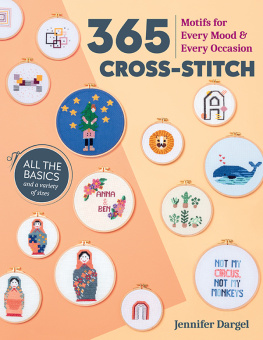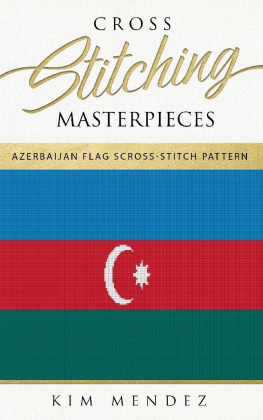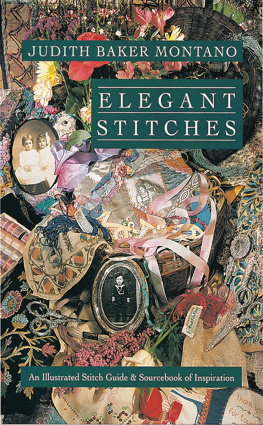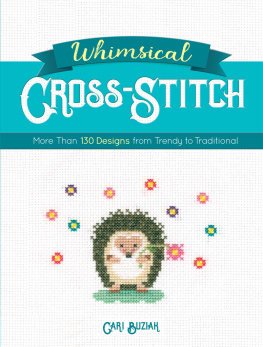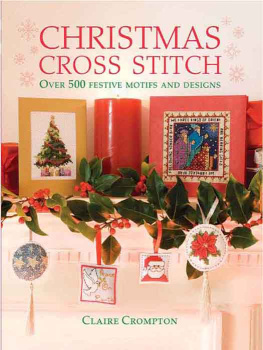CROSS STITCHING GUIDE FOR BEGINNERS
Cross Stitch Mastering in 7 Days
By
Faye Fetters
Copyrighted Material
Copyright 2018 Lost River Publishing House
All Rights Reserved.
No part of this publication may be reproduced, stored in a retrieval system or transmitted in any form or by any means, electronic, mechanical, photocopying, recording or otherwise without the proper written consent of the copyright holder, except as permitted under Sections 107 & 108 of the 1976 United States Copyright Act, without the prior written permission of the publisher.
Lost River Publishing House publishes its books and guides in a variety of electronic and print formats, Some content that appears in print may not be available in electronic format, and vice versa.

Cover design
Jasmin Rodriguez
First Edition
Contents Covered
Introduction to Cross Stitching
H ey there! My name is Faye Fetters, and Im going to teach you how to cross stitch. Whether its your first time doing it, you have some experience, or if youre an expert, Im sure youll learn something from this guide. Were going to be covering some basic stitches, materials needed, how to follow patterns and make your own, as well as how to finish and frame your work.
One thing to always keep in mind is that, as with all art, cross stitching is what you make of it. This guide is simply to be used as just that, a guide for basic tips and techniques. There are no hard and fast rules when it comes to cross stitching, so do whatever looks best to you and feels right.
Now, lets begin the journey.
T he materials for cross stitching are pretty straightforward.
- Needles
- Fabric
- Thread
- Snips (Scissors)
- Hoops and Frames
- Needle Minders
- Scroll Frames
Even though the materials themselves are straightforward, there are still plenty of options that exist within each category. (Fig. 1.1)

Needles

N eedles come in different sizes and shapes. The biggest difference will be how long and thick the needle shaft is and how big the hole, or eye, of the needle, is. This is important because if youre working on a fabric that has smaller holes, youll need a smaller needle.
The same is also true if youre working with fabric that has bigger holes, a larger needle is needed since youll be using more thread to allow the stitches to show. When you go to a craft store, its rare that youll see needles labeled Cross Stitch.
However, there are sets of needles that are used for embroidery, and these tend to work quite nicely for cross stitch as well. The cost of needles can vary but shouldnt run more than $5 for a set.
Fabric
T he fabric is the canvas of cross stitching. This is your base, and on it, youll be able to create anything that youd like. The most common type of fabric is called Adia fabric; its filled with small holes that are spaced out evenly. (Fig. 1.2)

The fabric comes in different sizes with the most common being 14 and 18 counts. The sizes denote how big or small the holes in the fabric are, the higher the number, the smaller holes, which means more stitches can be placed in a space.
The lower numbered Adia has bigger holes which makes it easier to see and count the stitches, for the patterns later in this book Ill notate what size of fabric I used that way you can gather a general idea for sizing. Most patterns notate what size of fabric was used when the pattern was created, or theyll specify how big or small the finished project will be based upon the size of the fabric used.
Adia fabric comes in a variety of colors such as blue, black, white, red, and others, but if you cant find the color that youre looking for its also possible to dye the white or cream fabric the color that you desire.
Adia fabric can be very stiff to work with, so if youre looking for something softer, its possible to soak it in warm water for a few minutes to help loosen up the weave of the fabric. Be cautious, however, not to soak it too long, or itll be too soft to work with effectively.
Threads

I f the fabric is the meat of cross stitching, then the thread is the potatoes. The thread comes in every color possible, from neutrals, whites, blacks, primary colors, to metallic and multicolored thread. The most common type of thread is DMC. Its cotton and comes in close to 500 different colors. But for any colors they dont make, theres another company that does.
The amount of thread you use depends on the size of the fabric and how full you want the stitches to look. Most people go for 14, and 18 count fabric and use 2-3 strands of thread, but again its up to you! Its your project(s), so make them uniquely your own. When using a thread, especially metallic thread, it can become tangled while working.
Some crafters swear by a product called Thread Heaven (which was recently discontinued), however, others dont use any product or say that beeswax works.
Personally, I dont use any product on my thread, and I dont have an issue. But, if youre finding that your thread is snagging or it's just a bother to work with, then you may want to use some sort of smoothing agents like beeswax or something similar.
Snips

S cissors, or snips as some call them, help with cutting thread and fabric for your projects. Most craft stores carry simple, small scissors in the embroidery or sewing sections. However, if youre looking for something more artistic or elaborate, sites like Etsy, Amazon, and other online retailers have a plethora of whimsical or smaller snips to choose from.
Some people pose the question, Well what if Im flying or traveling and dont want to/cant bring my scissors? Some airports allow smaller snips (always check with TSA guidelines though), but some people bring fingernail clippers or an empty dental floss container with them as a scissor substitute.
Next page


